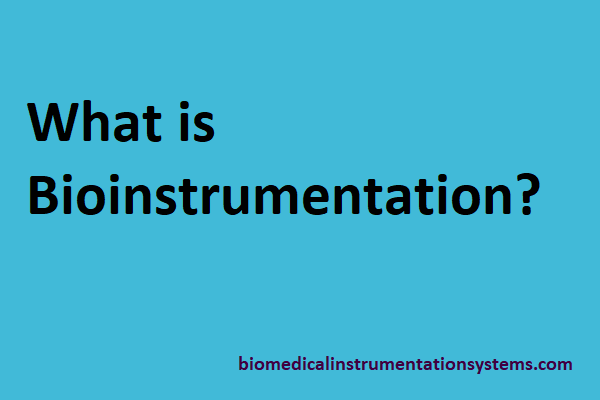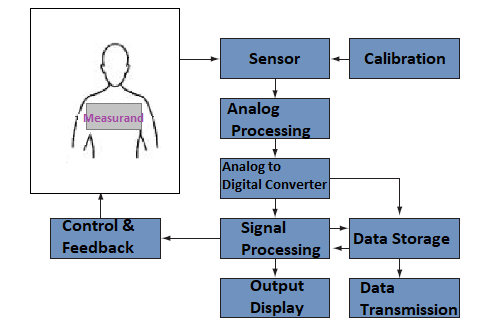Bioinstrumentation involves the measurement of current or voltage signals from the different parts of the body. The measurement of various physiological signals produced by the body helps in diagnosis and treatment of diseases. In actual fact, when we talk about bioinstrumentation we mean biomedical instrumentation.

Basic Bioinstrumentation System
The quantity, property, or condition that is measured by an instrumentation system is called the measurand. This can be a bioelectrical signal, such as those generated by the heart, muscles or the brain, or a chemical or mechanical signal that is converted to an electrical signal. Sensors are used to convert physical measurand into electric outputs. These outputs from these biosensors are analog signals, i.e. continuous signals that are sent to the analog processing and digital conversion block where they are amplified, filtered, conditioned and converted to digital form.

The above figure shows a basic bioinstrumentation system using sensors to measure a signal with data acquisition, storage and display capabilities, along with control and feedback.
Once the analog signals have been digitized and converted to a form that can be stored, and processed by digital computers, many more methods of signal conditioning can be applied.
The basic instrumentation system also includes output display devices that enable human operators to view the signal in a format that is easy to understand. These displays may be numerical or graphical, discrete or continuous, and permanent or temporary. Most of the output display devices are intended to be observed visually but some may provide audible output for instance, a beeping sound with each heartbeat.
Additionally, many bioinstrumentation systems have the capability of storing data. In some devices, the signal is stored briefly so further processing can take place or so an operator can examine the data. In other cases, the signals are stored permanently so different signal processing techniques can be applied at a later time.
Find out more about: Fingertip Pulse Oximeter Blood Oxygen Saturation Monitor
With the development of biotelemetry and telemedicine, signals can be acquired with a device in one location, maybe in a patient’s home, and transmitted to another device for processing and/or storage. This has allowed medical facilities in rural areas to transmit diagnostic images to tertiary care hospitals so that specialized physicians can help general practitioners arrive at more accurate diagnoses.
The calibration signal plays an important role in instrumentation systems. A signal with known amplitude and frequency is applied to the instrumentation system at the sensor’s input. The calibration signal allows the components of the system to be adjusted so that the output and input have a known, measured relationship. Without this information, it is impossible to convert the output of an instrument system into a meaningful representation of the measurand.
The feedback component, though not part of all bioinstrumentation systems, also plays an important in the measurement scheme. In devices like pacemakers and ventilators that stimulate the heart or the lungs some feedback is required. The feedback devices collect physiological data and stimulate a response, a heartbeat or breathe when needed or are part of biofeedback systems in which the patient is made aware of a physiological measurement, such as blood pressure, and uses conscious control to change the physiological response.
You may also read:
- The Essential Requirements of Biopotential Amplifiers for Medical applications
- 5 Types of Biomedical Instrumentation Systems
- Sources of Biomedical Signals
- Types of Transducers used in Biomedical Measurement Applications
- Types of Bioelectrodes
- How are the Potentials in the Body generated?

Leave a Reply
You must be logged in to post a comment.